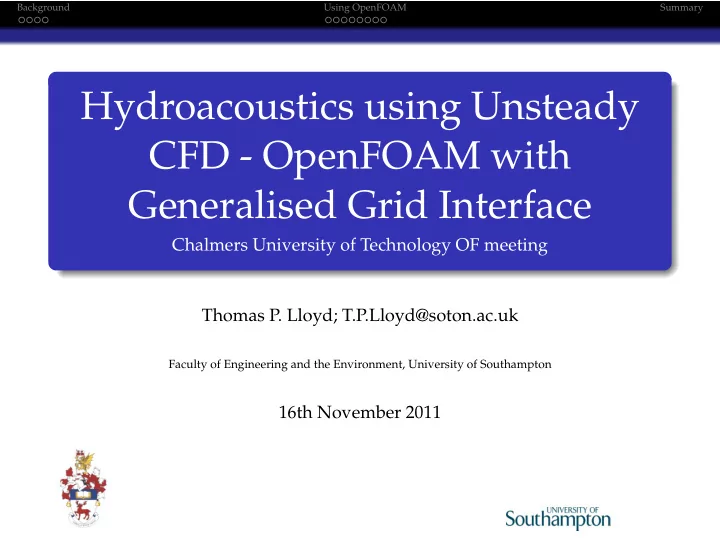

Background Using OpenFOAM Summary Hydroacoustics using Unsteady CFD - OpenFOAM with Generalised Grid Interface Chalmers University of Technology OF meeting Thomas P. Lloyd; T.P.Lloyd@soton.ac.uk Faculty of Engineering and the Environment, University of Southampton 16th November 2011
Background Using OpenFOAM Summary Outline Background 1 Hydroacoustics Turbulence modelling Using OpenFOAM 2 Results - TSG Summary 3
Background Using OpenFOAM Summary Hydroacoustics Background Turbomachinery simulations Noise important in numerous rotating devices Need to resolve turbulence which is the noise source Choice of turbulence model important
Background Using OpenFOAM Summary Hydroacoustics Background Turbomachinery simulations Noise important in numerous rotating devices Need to resolve turbulence (which is the noise source) Choice of turbulence model important Christophe et al. (2010)
Background Using OpenFOAM Summary Turbulence modelling Turbulence modelling Acoustic sources Turbulence interacting with surfaces Ideally use wall-resolved LES - fine near-wall mesh Reynolds number/complex geometries mean hybrid RANS/LES currently more feasible Chosen turbulence model Common hybrid RANS/LES model - DES Numerous modifications proposed and implemented Improved Delayed DES (IDDES) currently used
Background Using OpenFOAM Summary Turbulence modelling Turbulence modelling DES versus IDDES LES region RANS region LES region RANS region
Background Using OpenFOAM Summary Results - TSG Timisoara swirl generator test case Case set-up Solver: pimpleDyMFoam Turbulence model: IDDES LES filter: cube root volume Initial condition: URANS data, as supplied ∆ t :4x10 − 5 s (CFL=1) Total time: 0.01s (One flow-through = 0.45 s )
Background Using OpenFOAM Summary Results - TSG Timisoara swirl generator test case Iso-surface of Q = 10 4 s − 2 URANS solution IDDES solution
Background Using OpenFOAM Summary Results - TSG URANS Close Up Iso-surface of Q = 10 4 s − 2 URANS solution
Background Using OpenFOAM Summary Results - TSG IDDES Close Up Iso-surface of Q = 10 4 s − 2 IDDES solution
Background Using OpenFOAM Summary Results - TSG Window 0 URANS solution IDDES solution
Background Using OpenFOAM Summary Results - TSG Window 1 URANS solution IDDES solution
Background Using OpenFOAM Summary Results - TSG Window 2 URANS solution IDDES solution
Background Using OpenFOAM Summary Results - TSG Blade surface pressures y + Runner blade surface pressure (Pa) 1
Background Using OpenFOAM Summary Summary Areas of Interest using OpenFOAM Unsteady turbomachinery flows Using the GGI Using hybrid RANS/LES turbulence models Using inflow turbulence generators
Background Using OpenFOAM Summary Summary Areas of Interest using OpenFOAM Unsteady turbomachinery flows Using the GGI Using hybrid RANS/LES turbulence models Using inflow turbulence generators Summary Hydroacoustics requires unsteady simulations and resolved turbulence For low Mach number flows, accurate prediction of surface pressures Hybrid RANS/LES models offer accuracy/expense balance Specifying inlet turbulence important OpenFOAM has the potential to accommodate all requirements
Background Using OpenFOAM Summary T.P.Lloyd@soton.ac.uk Thank you for your attention. Do you have any questions?
Recommend
More recommend